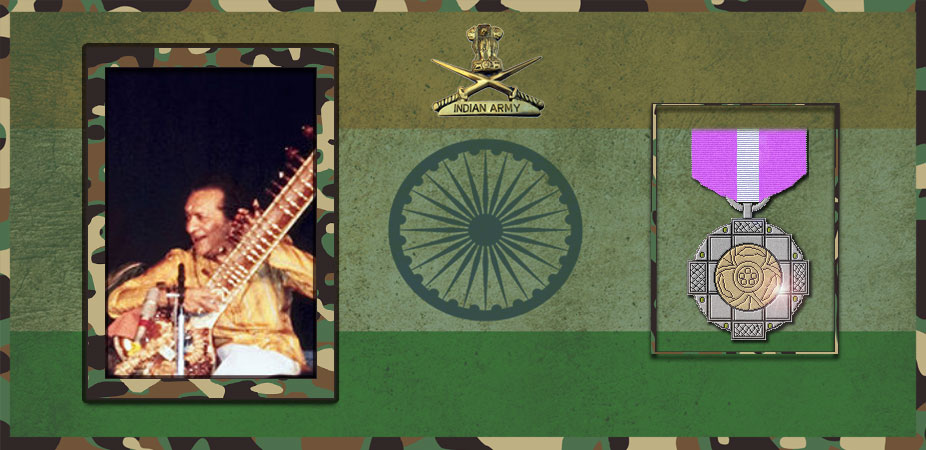Let's salute to our Indian Army together, We are proud to be Indian.
Let's salute to our Indian Army together, We are proud to be Indian.

Ravi Shankar, KBE (IPA: 7 April 1920 – 11 December 2012), born Rabindra Shankar Chowdhury, his name often preceded by the title Pandit (‘Master’), was a Bengali Indian musician and a composer of Hindustani classical music. He was one of the best-known proponents of the sitar in the second half of the 20th century and influenced many other musicians throughout the world.
Shankar was born to a Bengali family in India,and spent his youth touring India and Europe with the dance group of his brother Uday Shankar. He gave up dancing in 1938 to study sitar playing under court musician Allauddin Khan. After finishing his studies in 1944, Shankar worked as a composer, creating the music for the Apu Trilogy by Satyajit Ray, and was music director of All India Radio, New Delhi, from 1949 to 1956.
In 1956 he began to tour Europe and the Americas playing Indian classical music and increased its popularity there in the 1960s through teaching, performance, and his association with violinist Yehudi Menuhin and Beatles guitarist George Harrison. His influence on the latter helped popularize the use of Indian instruments in pop music throughout the 1960s. Shankar engaged Western music by writing compositions for sitar and orchestra, and toured the world in the 1970s and 1980s. From 1986 to 1992, he served as a nominated member of Rajya Sabha, the upper chamber of the Parliament of India. He continued to perform until the end of his life. In 1999, Shankar was awarded India’s highest civilian honour, the Bharat Ratna.
Shankar was born on 7 April 1920 in Benares, then the capital of the eponymous princely state, in a Bengali family, as the youngest of seven brothers. His father, Shyam Shankar Chowdhury, was a Middle Temple barrister and scholar from East Bengal (now Bangladesh). A respected statesman, lawyer and politician, he served for several years as dewan (Prime minister) of Jhalawar, Rajasthan, and used the Sanskrit spelling of the family name and removed its last part.Shyam was married to Hemangini Devi who hailed from a small village named Nasrathpur in Mardah block of Ghazipur district, near Benares and her father was a prosperous landlord. Shyam later worked as a lawyer in London, England,and there he married a second time while Devi raised Shankar in Benares, and did not meet his son until he was eight years old. Shankar shortened the Sanskrit version of his first name, Ravindra, to Ravi, for “sun”.Shankar had six siblings, only four of whom lived past infancy: Uday (who became a famous choreographer and dancer), Rajendra, Debendra and Bhupendra. Shankar attended the Bengalitola High School in Benares between 1927 and 1928.
At the age of ten, after spending his first decade in Benares, Shankar went to Paris with the dance group of his brother, choreographer Uday Shankar.By the age of 13 he had become a member of the group, accompanied its members on tour and learned to dance and play various Indian instruments. Uday’s dance group toured Europe and the United States in the early to mid-1930s and Shankar learned French, discovered Western classical music, jazz, cinema and became acquainted with Western customs.Shankar heard Allauddin Khan – the lead musician at the court of the princely state of Maihar – play at a music conference in December 1934 in Calcutta, and Uday convinced the Maharaja of Maihar in 1935 to allow Khan to become his group’s soloist for a tour of Europe.Shankar was sporadically trained by Khan on tour, and Khan offered Shankar training to become a serious musician under the condition that he abandon touring and come to Maihar.
Shankar developed a style distinct from that of his contemporaries and incorporated influences from rhythm practices of Carnatic music.His performances begin with solo alap, jor, and jhala (introduction and performances with pulse and rapid pulse) influenced by the slow and serious dhrupad genre, followed by a section with tabla accompaniment featuring compositions associated with the prevalent khyal style.Shankar often closed his performances with a piece inspired by the light-classical thumri genre.
Shankar has been considered one of the top sitar players of the second half of the 20th century. He popularised performing on the bass octave of the sitar for the alap section and became known for a distinctive playing style in the middle and high registers that used quick and short deviations of the playing string and his sound creation through stops and strikes on the main playing string. Narayana Menon of The New Grove Dictionary noted Shankar’s liking for rhythmic novelties, among them the use of unconventional rhythmic cycles. Hans Neuhoff of Musik in Geschichte und Gegenwart has argued that Shankar’s playing style was not widely adopted and that he was surpassed by other sitar players in the performance of melodic passages.Shankar’s interplay with Alla Rakha improved appreciation for tabla playing in Hindustani classical music.Shankar promoted the jugalbandi duet concert style and claims to have introduced new ragas Tilak Shyam, Nat Bhairav and Bairagi.
Indian governmental honours
Other governmental and academic honours
Arts awards
Other honours and tributes